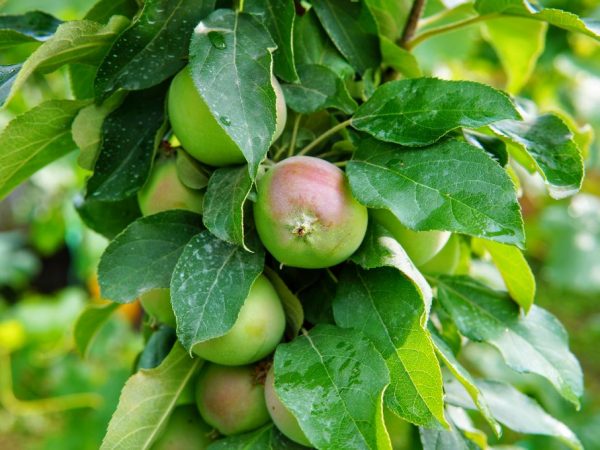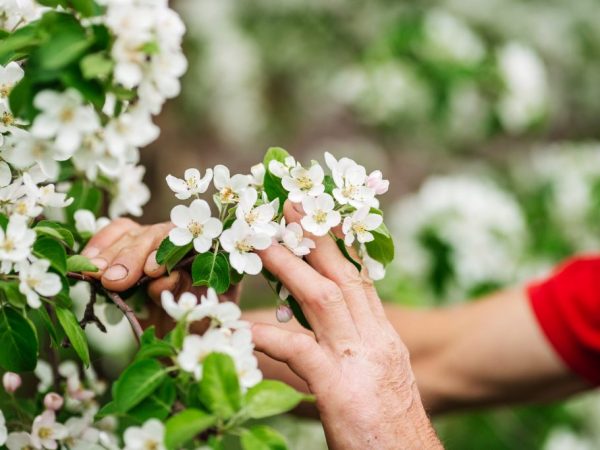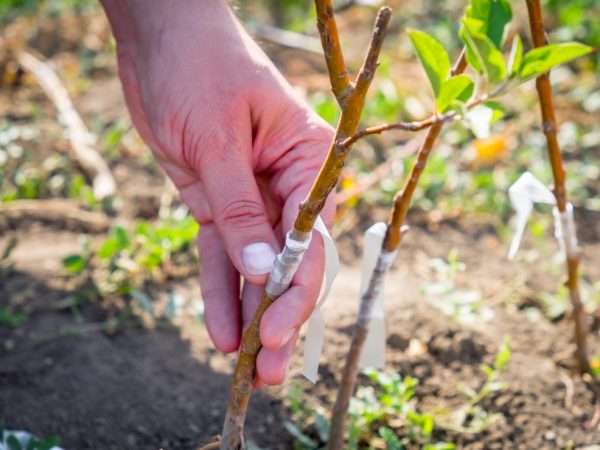Rules for planting apple trees in the Urals
Despite the cold weather conditions, planting apple trees in the Urals is possible. Not all varieties are suitable for this region. It is necessary to plant only frost-resistant varieties that will bear fruit even after a cold winter.

Rules for planting apple trees in the Urals
Variety selection
In the Urals, winter-hardy varieties are cultivated, in which fruiting occurs in summer, autumn or winter. The cultivation of any sort of apple tree depends on the climate of the Ural region and the timing of the fruiting of the culture. By describing each species, it is easier to make the right choice.
Antonovka
This is the most frost-resistant variety related to the Ural selection. The tree grows up to 5 m in height with a wide pyramidal crown. The mass of each apple is in the range of 100-200 g.
The peel is yellow with a green sheen. The pulp is white, juicy. The fruits are sour to taste, but this does not prevent them from being in demand among gardeners. The first apples ripen in September.
Full maturity, after which the fruits are harvested for storage, occurs in October. Antonovka retains its characteristics for only 2-3 months.
White filling
In the conditions of this region, White filling is often grown, belonging to the Ural selection. This variety is not suitable for storage for the winter, because it deteriorates after 2 weeks. The height of the tree is 3 m.
The crown is oval, compact. The weight of an individual apple is 100 g. Its shape is round and the skin is green. The first harvest is carried out in early August. Up to 130 kg of harvest is harvested from each tree.
Melba
The variety belongs to frost-resistant crops with an average ripening period. Description of the variety:
- tree height - 2-3 m;
- crown of an oblong shape;
- light green fruits reach a weight of 220 g;
- pulp with a sweet taste and caramel flavor;
- fruits are stored for a long time - within 5 months;
- harvesting is carried out in August;
- high yield - 130-170 kg per tree.
Folding
Well suited for growing in the Urals, because the variety is frost-resistant. The variety ripens at the end of summer, and its fruits are stored only until October.
Papirovka needs pollinators (for example, Welsey) to be planted next to it. A dense pyramidal crown is formed on a tall tree (up to 4 m). Fruits are yellow-green, rounded, with ribbed skin. The weight of each apple is from 100 to 120 g. The yield is good - up to 200 kg of fruits are harvested from each tree.
Welsey
The undersized variety belongs to winter crops. She was bred in America. The harvest dates are at the end of September. The crown of the tree is pyramidal. Oval-shaped apples weigh 100 g.
The shelf life of the fruits is good. If the crop is harvested in September-October, it will be stored until January. The disadvantages of this variety are its low yield (up to 100 kg per tree) and average frost resistance.
Landing

Some apple trees start to bloom quickly.
In order for the cultivation of an apple tree in the Urals to give a good result, planting is carried out according to certain rules. First, the gardener chooses the variety that suits him.
After that, they begin to determine the timing of planting seedlings. It is important to choose a suitable place for planting them so that the fruitfulness of the tree is maximized.
Timing
A high survival rate of seedlings in the Urals is observed after planting an apple tree in spring or autumn. The optimal time is September or October, when foliage will fall from the trees. This will allow the apple tree to thrive as it gets warm in the spring. Autumn planting has a disadvantage - if a cold snap comes early, the root system will suffer.
In the Urals, planting is carried out in the spring. Wait until the snow has melted, but the buds on the trees have not yet blossomed. During the summer period, the roots of the apple tree will get stronger and will be ready for winter frosts.
Site preparation
Planting is carried out in sunny areas. Try to choose places on the south side of the garden. Protect the apple tree from drafts. It is better to place seedlings on hills so that moisture does not stagnate in the root system.
For an apple tree, loamy soil with a low acidity content is suitable. Good development of culture is observed if there are enough mineral components in the soil: nitrogen, phosphorus and potassium. Due to this, you will increase the yield of each variety.
It is impossible for groundwater to come close to the surface of the earth. If you are growing tall varieties, their depth should be within 6 m.For low-growing crops, 3 m is enough.
Preparing a planting site consists of removing weeds and digging up the entire area. Depth - 1 shovel bayonet. Feed the soil with organic fertilizers (10 kg of humus or 3 kg of sawdust per 1 m²). If the soil is with an increased level of acidity, lime is added to it (3 kg per 1 m²). Sand is added to the clay.
A hole is prepared a few weeks before planting. During this time, it will settle. The top layer of the earth is not thrown away, but left for burying seedlings. 5 kg of humus and 10 liters of warm water are poured into the pit. Depending on the size of the root system, the diameter of the hole should be between 50 and 90 cm.
If the site is low-lying, drainage is installed to avoid the accumulation of moisture. For this, crushed stone is used. In 20-30 minutes. before planting, one part of the upper soil is poured inside. For greater fertility of the land, it is mixed with humus in a 1: 1 ratio.
Landing technology
Planting apple trees in the Urals according to the proposed instructions:
- the roots of the seedling are straightened so that there are no knots. To the left or to the right of it, a support is driven in, to which a tree will then be tied;
- a seedling is placed in the hole and sprinkled with earth. To eliminate voids in the root system, the soil is periodically compacted. The root collar is left above the ground;
- tie a young tree to a support and water it with 15 liters of warm water;
- tall varieties are planted at a distance of 7 m from each other. For low-growing crops, a distance of 4 m is sufficient. If the distance between the trees is not enough, their growth will slow down, and the yield will be low. To plant columnar varieties, keep a distance of 1 m. Leave 2 m between the rows.
Care

Good advice will help you grow a good tree
It is not enough to plant seedlings and wait for a good harvest. Taking care of crops in the Urals is not difficult if you know the basic principles. Care in cold regions should be more effective than in the central or southern parts of the country.
To ensure growth and fruiting, the tree must be provided with high-quality watering, regular feeding. It is also important to cover the apple trees for the winter. If you are growing bushy varieties, pruning will help improve yields.
Watering
The first stage of care is watering. There are several basic rules for its implementation:
- only warm water is allowed to be poured - cold water provokes deformation of the root system;
- the regularity of watering young apple trees - twice a week;
- adult trees are watered only in summer, adding 20 liters of warm water under each;
- 3 days after watering, the trunk circle is loosened - this will provide the soil with good aeration;
- in the root zone, soil is mulched to retain moisture in the soil.
Top dressing
The first fertilization is carried out the next year after planting. Top dressing is applied in spring or autumn. If the summer is hot, it is allowed to add nitrogen substances once. Before flowering, mineral fertilizers are used in the form of ammonium nitrate (40 g per 6 liters of water).
The next top dressing takes place in September, a week before harvest. During this period, use humus or potassium (4 kg of organic matter or 200 g of minerals for each tree).
To increase the yield, the ground part of the tree is watered with nutrients a week before harvesting. Mix 400 g of complex fertilizer ("Kemira" or "Azofoska") with 10 liters of water. 3 liters of solution are poured under each seedling.
Pruning and shaping the crown
If the seedling was planted in the spring, the main shoot is removed. When planting in autumn, this cannot be done, because in winter the tree will freeze. In the first year, all inflorescences are removed so that the culture saves energy during frosts.
Sanitary pruning is done in the spring. At this time, all diseased and damaged branches are removed in order to improve the development of the seedling. Rejuvenating pruning is needed in the fall with an interval of 2-3 years.
Remember to shape the crown to keep the tree looking beautiful and healthy. The first procedure occurs in the second year after planting. Most of the shoots are removed to stimulate branch development.
Vaccinations
Vaccinations are done at the end of July. Summer varieties are grafted first, and then autumn and winter ones. The most common method of budding is by the bark. On the cuttings, remove all the foliage, leaving only the stalks.
After that, the stalk is inserted into the T-shaped incision that is located on the rootstock. The attachment point is wrapped with tape or plastic wrap, without affecting the kidney. To minimize evaporation, the incision is treated with garden varnish.
Shelter for the winter
You will get quality apples if you provide the trees with protection for the winter. To do this, tie a bag around the trunk, and place the crown under a film or agrofibre.
The trunk circle is covered with mulch using rotted manure. Its height should be at least 10 cm. Fallen leaves are poured on top of this layer.
Disease and pest control
Caring for a tree also means protecting it from diseases and pests. A common parasite that attacks apple trees growing in the Urals is the moth. If not destroyed, it will ruin the crop at the stage of ovary formation.
Prevention against the moth consists in the destruction of dry foliage and digging up the trunk circle. Bordeaux liquid (100 g per 10 l of water) helps to fight this pest, with which monthly spraying is carried out.
Scab is isolated from diseases. A solution of copper sulfate (200 g per 10 l of water) or tincture of onion peel (500 g per 5 l of water) helps to cope with it. Trees are treated with them every 14 days.

